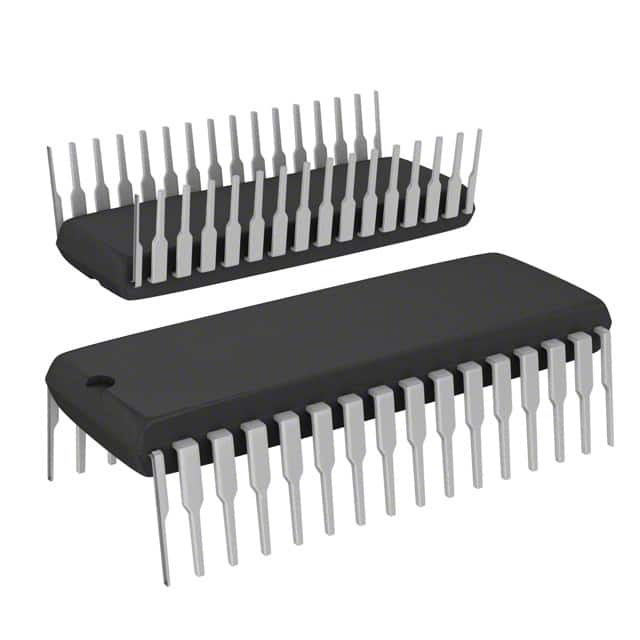Voir les spécifications pour les détails du produit.

ST72C215G2B6
Product Overview
Category
The ST72C215G2B6 belongs to the category of microcontrollers.
Use
This microcontroller is commonly used in various electronic devices and systems for control and processing tasks.
Characteristics
- High-performance 8-bit microcontroller
- Low power consumption
- Integrated peripherals for enhanced functionality
- Wide operating voltage range
- Robust design for reliable operation
Package
The ST72C215G2B6 is available in a compact and industry-standard package, making it suitable for easy integration into different applications.
Essence
The essence of the ST72C215G2B6 lies in its ability to provide efficient control and processing capabilities in a wide range of electronic systems.
Packaging/Quantity
The microcontroller is typically packaged individually and is available in various quantities depending on the specific requirements of the application.
Specifications
- Architecture: 8-bit
- CPU Frequency: Up to 16 MHz
- Program Memory Size: 32 KB Flash
- Data Memory Size: 1.5 KB RAM
- Operating Voltage Range: 2.7V to 5.5V
- Number of I/O Pins: 20
- Communication Interfaces: UART, SPI, I2C
- Timers/Counters: 3
- Analog-to-Digital Converter (ADC): 8 channels, 10-bit resolution
- Operating Temperature Range: -40°C to +85°C
Detailed Pin Configuration
The ST72C215G2B6 has a total of 20 pins, each serving a specific purpose. The pin configuration is as follows:
- VDD - Power supply voltage
- GND - Ground
- PA0 - General-purpose I/O pin
- PA1 - General-purpose I/O pin
- PA2 - General-purpose I/O pin
- PA3 - General-purpose I/O pin
- PA4 - General-purpose I/O pin
- PA5 - General-purpose I/O pin
- PA6 - General-purpose I/O pin
- PA7 - General-purpose I/O pin
- PB0 - General-purpose I/O pin
- PB1 - General-purpose I/O pin
- PB2 - General-purpose I/O pin
- PB3 - General-purpose I/O pin
- PB4 - General-purpose I/O pin
- PB5 - General-purpose I/O pin
- PB6 - General-purpose I/O pin
- PB7 - General-purpose I/O pin
- RESET - Reset pin
- OSCIN/OSCOUT - Oscillator input/output pins
Functional Features
The ST72C215G2B6 offers several functional features that enhance its performance and versatility:
- High-speed processing capabilities for efficient execution of tasks
- Integrated communication interfaces for seamless connectivity with other devices
- On-chip memory for storing program code and data
- Timers/counters for precise timing and event management
- Analog-to-digital converter for capturing analog signals
- Low power consumption for energy-efficient operation
- Robust design for reliable performance in harsh environments
Advantages and Disadvantages
Advantages
- High-performance microcontroller suitable for a wide range of applications
- Low power consumption extends battery life in portable devices
- Integrated peripherals reduce the need for external components
- Wide operating voltage range allows compatibility with different power sources
- Robust design ensures reliable operation even in challenging conditions
Disadvantages
- Limited program memory size may restrict the complexity of applications
- 8-bit architecture may not be sufficient for certain demanding tasks
- Availability of alternative models with more advanced features
Working Principles
The ST72C215G2B6 operates based on the principles of digital logic and microcontroller architecture. It executes instructions stored in its program memory, interacts with external devices through input/output pins, and utilizes integrated peripherals to perform various tasks. The microcontroller's central processing unit (CPU) fetches, decodes, and executes instructions, enabling it to control and process data according to the programmed logic.
Detailed Application Field Plans
The ST72C215G2B6 finds applications in a wide range of fields, including but not limited to:
- Industrial Automation: Control systems for machinery and equipment
- Automotive Electronics: Engine management, dashboard displays, and control modules
- Consumer Electronics: Home appliances, gaming consoles, and audio/video devices
- Medical Devices: Patient monitoring systems and diagnostic equipment
- Internet of Things (IoT): Smart home automation, sensor networks, and wearable devices
Detailed and Complete Alternative Models
For those seeking alternative microcontrollers with similar capabilities, the following models can be considered:
- ST72F264G2B6
- PIC16F877
Énumérez 10 questions et réponses courantes liées à l'application de ST72C215G2B6 dans les solutions techniques
Sure! Here are 10 common questions and answers related to the application of ST72C215G2B6 in technical solutions:
Q: What is the ST72C215G2B6 microcontroller used for? A: The ST72C215G2B6 microcontroller is commonly used in various technical solutions, including industrial automation, consumer electronics, automotive applications, and more.
Q: What is the maximum clock frequency supported by the ST72C215G2B6? A: The ST72C215G2B6 microcontroller supports a maximum clock frequency of 16 MHz.
Q: How much flash memory does the ST72C215G2B6 have? A: The ST72C215G2B6 microcontroller has 32 KB of flash memory.
Q: Can I use the ST72C215G2B6 for real-time applications? A: Yes, the ST72C215G2B6 microcontroller can be used for real-time applications as it offers interrupt handling capabilities and timers.
Q: Does the ST72C215G2B6 support analog-to-digital conversion (ADC)? A: No, the ST72C215G2B6 microcontroller does not have an integrated ADC. External ADCs can be used if analog inputs are required.
Q: What communication interfaces are available on the ST72C215G2B6? A: The ST72C215G2B6 microcontroller supports UART (Universal Asynchronous Receiver-Transmitter) and SPI (Serial Peripheral Interface) communication interfaces.
Q: Can I program the ST72C215G2B6 using C language? A: Yes, the ST72C215G2B6 microcontroller can be programmed using the C language. The ST Visual Develop (STVD) IDE and Cosmic C Compiler are commonly used for development.
Q: What is the operating voltage range of the ST72C215G2B6? A: The ST72C215G2B6 microcontroller operates within a voltage range of 2.7V to 5.5V.
Q: Does the ST72C215G2B6 have built-in EEPROM memory? A: No, the ST72C215G2B6 microcontroller does not have built-in EEPROM memory. External EEPROMs can be used if non-volatile storage is required.
Q: Is the ST72C215G2B6 suitable for low-power applications? A: Yes, the ST72C215G2B6 microcontroller has low-power consumption features, making it suitable for battery-powered or energy-efficient applications.
Please note that these answers are based on general information about the ST72C215G2B6 microcontroller and may vary depending on specific implementation requirements.

